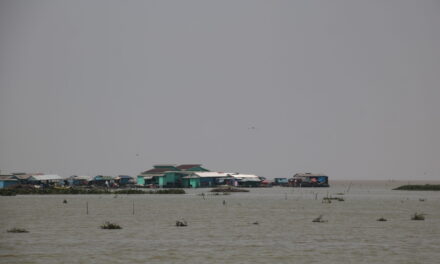As stricter environmental laws and occupational safety standards made disposal of toxic and hazardous waste expensive in rich industrialised nations, waste generators and brokers have made developing countries (including Eastern and Central European countries) convenient dumping grounds for “the effluent of the affluentâ€. The stories of toxic dumping show a callous disregard for human life and the environment. One of the most famous cases was the notorious Khian Sea, a barge that contained 13,500 tons of toxic incinerator ash from Philadelphia. From 1986 to 1988, the Khian Sea roamed the globe in search of a dumping ground. It tried but was unable to dump the waste in the Bahamas, the west coast of Africa, the Philippines, Indonesia, Sri Lanka, and Singapore, but it did manage to dump 4,000 tons on Gonaives Beach in Haiti before it was stopped. Its remaining cargo was apparently dumped somewhere in Asia.
In 1991, four US companies based in South Carolina participated in a scheme to dump thousands of tons of toxic material contaminated with lead and cadmium in Bangladesh. About 1,000 tons of the toxic waste disguised as fertiliser had already been applied by farmers to their fields before this was exposed by Greenpeace. Although part of the penalties imposed by a US Court was used to take back the waste, no provisions were made to clean up toxic waste from farms in Bangladesh.
Perhaps the most deceptive form of dumping is “recycling†waste in other countries. From 1990 to 1993, 5.3 million tons of waste were shipped from five developed countries (US, Canada, Japan, Australia, and Germany) to Asian countries of Bangladesh, China, Hong Kong, India, Indonesia, Malaysia, Pakistan, Philippines, Sri Lanka, Taiwan, and Thailand. These included not only household garbage and plastics that end up being buried somewhere, but also incinerator ash, lead-acid batteries, wastes containing other toxic metals, and medical waste.
Because safe disposal of lead can be costly and lead-acid battery recycling requires strong measures for occupational safety and stringent environmental controls, unscrupulous brokers have sent battery scrap to poorer countries with non-existent or unenforced occupational safety and environmental regulations. Thus, toxic levels of lead have ended up in soil, rivers, air. The Center for Investigative Reporting (San Francisco) revealed in 1990 that car batteries from the US were being sent to factories in Taiwan. Workers at the plants complained of health problems and were later found to be suffering from lead poisoning. It was reported that one of the factories dumped thousands of tons of waste in an open field and children at schools near both plants were found to have high levels of lead in their blood.
Reports of lead dumping abound, in Thailand, India, Mexico, Indonesia, and the back streets of Manila, among many others. Children living in the vicinity of Philippine Recyclers Inc. (PRI) in Marilao, Bulacan, have elevated lead levels in their blood, based on a recent study by Greenpeace and the University of the Philippines College of Public Health. PRI, a subsidiary of Ramcar Batteries of Commerce City, California, processed more than 4,000 tons of scrap batteries per month. Since 1991, the Philippines has imported more than 76,000 tons of lead-acid batteries; as pointed out by Von Hernandez of the Greenpeace Southeast Asia Toxics Campaign, that is enough to fill 38,000 40-foot long container vans.
Lead enters the body by being inhaled or ingested. Even at very low concentrations, lead affects the nervous system, blood cells, kidneys, and reproductive system. Symptoms of chronic lead poisoning include vomiting, abdominal pain, stupor, and loss of muscular coordination. Lead can cross the placenta of pregnant women and damage the foetus. Lead has adverse effects on the development of children: very low levels in the blood can cause anaemia and brain damage. For children and adults, increasing lead levels result in mental loss (speech and writing problems, mental retardation) and eventually, irreversible brain damage.
The major countries exporting lead waste to developing countries are the United States, Australia, Japan, and the United Kingdom.
Ratification of the Basel Convention
One approach for dealing with the toxic waste problem is preventing it in the first place. In recent years, many governments and non-governmental organisations (NGOs) have worked on legal instruments proscribing the insidious practice of disposing toxic wastes in developing countries. Africa was a favourite dumping ground for many years. African countries (except Morocco) are now protected from the dumping of toxic cargo by the Bamako Convention. Mediterranean countries have developed the Regional Waste Trade Protocol under the Barcelona Convention. There is a similar Regional Agreement on Transboundary Movements of Hazardous Wastes covering Central America. As other regions have clamped down on toxic dumping, Asia and the Pacific have become the most vulnerable region for dumping from industrialised countries.
The Basel Convention on the Transboundary Movement of Hazardous Waste was adopted in 1989. Despite strong pressure to weaken the Basel ban by several industrialised countries, especially the United States and Australia, and by waste trade industry representatives, the Basel ban prohibits the export for final disposal of hazardous waste to non-members of the OECD (Organisation for Economic Cooperation and Development) immediately. It will ban export of hazardous waste for the purpose of recycling in 1998. The Basel ban is legally binding on more than a hundred countries that are contracting parties to the convention. However, two-thirds of the parties (about sixty countries) must ratify the ban and incorporate it into their national laws in order for the ban to enter into force. The United States has been trying to find ways to circumvent the ban.
Notwithstanding the lengthy phase-out period pertaining to recycling of hazardous waste, the ban is an important international response to the danger of the toxic waste trade. There is concern, however, that in the coming year, unscrupulous waste traders will dumped large amounts of hazardous waste for recycling before the 1998 deadline. Pressure should be put to bear on countries to ratify the Basel ban, in particular, the United States — one of the industrialised countries most responsible for toxic dumping in developing countries and the only OECD country that is not a contracting party to the Convention.
NGOs could support organisations, notably the Greenpeace International Toxics Campaign, which investigate and document the toxic waste trade, monitor convention meetings and lobby to strengthen the Ban. APEC-member governments should be pressured to ratify the Basel Convention. Moreover, governments and NGOs should ensure that there is strict enforcement of the Ban. Closing the door on toxic waste dumping in the Asia-Pacific region may eventually force industrialised countries to minimise waste generation, reduce over-consumption, and “close the loop†domestically through local recycling industries.
Uncontrolled industrial growth and toxic waste
While stopping the import of hazardous waste into the region is one approach to preventing toxic contamination, minimising toxic wastes generated by industrialisation is another. Rapid growth in East Asia, fuelled largely by foreign investment and trade openness, has come at the expense of the environment. The largest dumping ground of hazardous waste is the air, as tons of toxic pollutants are emitted from cars and trucks as well as from coal-fired plants, chemical processing plants, cement factories, smelters, and other pollution-intensive industries. Major air pollutants include particulate matter, gases that form acid rain (oxides of sulfur and nitrogen), carbon monoxide, toxic metals, as well as numerous organic compounds. These pollutants are dispersed in the atmosphere and can travel across national boundaries and can be deposited back on the ground through rain. Some pollutants react in the atmosphere to form acid rain, photochemical smog, or other toxic compounds. The major long-term health and environmental effects of these pollutants are well established.
Surface water, such as rivers, streams, and the ocean, has long been a convenient dump for toxic waste — as a place for direct discharge of wastewater and sludge, ocean dumping, or the eventual recipient of pollutant-laden storm drainage, run-off, siltation, mining tailings, accidental spills, etc. Different toxic contaminants in the water can be transported by water flow to communities downstream, they can be adsorbed in sediment from which they can slowly be released for many years, or they could accumulate in marine life and enter the food chain. Toxic wastes have also been dumped on the ground. Depending on the chemical properties of the waste and the environmental conditions, toxic contaminants can evaporate and pollute the air, be taken up by plants and animals and eventually move up the food chain, be transported to other areas by run-off during rainy seasons, percolate through the soil and contaminate drinking water supplies, and/or simply stay on the soil.
Toxic contamination involves the release of toxic chemicals and their subsequent migration to different environmental media. The risk to health and the environment rises as one or more completed pathways of exposure to vegetation, animal, and human populations are completed. Toxic waste can adversely disrupt the ecosystem, overwhelming natural restorative processes, destroying habitats, killing off sensitive species, and markedly reducing bio-diversity. The human health effects from chronic (long-term), low- dose exposure to different toxic compounds range from disorders of the lungs, liver, kidneys, and other organs, to adverse effects on the immune, reproductive, or central nervous systems, as well as mutations of genes and a variety of cancers.
There are several approaches to minimising toxic waste. In the immediate term, polluting industries can be required to install end-of-the-pipe abatement technologies to remove pollutants before the effluent is released to the environment. For a particular industrial operation, the best available control technology or the highest level of emission control found worldwide can be identified and new operations can be made to meet those standards. For existing operations, an appropriate combination of penalties and incentives can be used to bring the rest of the industry to those higher standards. These technology-based standards can be supplemented by risk-based standards or standards based on the “whole effluent toxicityâ€. It is also important to develop comprehensive strategies to eliminate loopholes that allow facilities to merely transfer pollutants from one environmental medium to another.
Another approach is to require industrial facilities to reduce the source of waste by implementing good operating practices including material handling improvements and inventory control to eliminate loss of material from expired shelf life or improper storage. Operational changes such as improved process control and adjustments in operational settings may also reduce toxic waste generation. Also important are possible product substitutions or changes in product composition to reduce toxicity or the amount of waste generated. Recycling is the use or reuse of materials from the waste stream or the recovery of materials from the waste stream as a product or for regeneration. Recycling programs can result in cost reductions in a facility.
For the longer term, investments in the region should place a high priority on implementing the highest clean production standards achievable worldwide. The US and Taipei sponsored “Clean Production/Clean Technology†initiative may be a step in the right direction unless it becomes a way to sell energy-intensive or otherwise inappropriate technologies which could have other detrimental effects on local communities. These and other initiatives lack mechanisms for allowing the participation of NGOs and community groups who have a stake in clean production and clean technologies.
US military’s toxic waste legacy
Most people associate toxic waste solely with industry. However, military facilities and operations also generate large quantities of hazardous waste from production, testing, cleaning, maintenance, and use of weapons, explosives, aircraft, naval vessels, land transport, etc. as well as storage and distribution of petroleum, oil, and lubricants (POL). Toxic solvents, oils, greases, corrosives, fuels, heavy metals, PCBs, dioxins, unexploded ordnance, and radioactive material are some of the hazardous wastes emitted or discharged directly into soil, air, or water by the military.
For decades, the US Department of Defence was one of the worst violators of US environmental laws. As a result, there are over 22,000 contaminated sites in 3,300 active and former military installations in the United States. Many of these are included in the so-called ‘Superfund’ list of the most contaminated and dangerous sites. This problem extends to overseas US bases including bases in Asia and the Pacific.
A case in point is Anderson Air Force Base in Guam. For decades, the US military simply dumped toxic waste on the ground. Unfortunately, Anderson sits directly above the major aquifer which is the primary source of drinking water for three-fourths of the population. In one US government report, the levels of trichloroethylene in the groundwater were several times higher than US federal government limits. Trichloroethylene, an industrial solvent used extensively by the military, is a suspected carcinogen and can also damage the liver and kidneys.
Many of you may recall the disastrous Pinatubo volcanic eruption in 1991, ending nearly a century of military operations at Clark Air Base in the Philippines. More than a year later, a refugee center was opened in a place called CABCOM (standing for Clark Air Base Command) to house 17,000 families displaced by Pinatubo. In 1994, families began complaining of gastrointestinal disorders and skin rashes which they believed were linked to their use of water from some wells that had been dug up at CABCOM. The refugee site is situated on what was once a major motorpool and vehicle maintenance area of the former US military base. Since this area was a former US base and lacking financial and technical resources, then Secretary of Health Dr Jaime Tan wrote a letter in 1995 to his US counterparts, specifically the Centers for Disease Control, asking for assistance to test the drinking water wells. The response took several months. The State Department, which apparently had to approve such assistance, placed the condition that the Philippine government, with its limited resources, had to pay for any assistance.
The US government has failed to do what is right and just, and to accept responsibility for the toxic legacy of its former bases in another country. The US left behind about two dozen major and minor facilities throughout the Philippines. In 1992, after the withdrawal from Clark, the US was forced to withdraw from Subic Naval Base when the Philippine Senate rejected a treaty that would have extended its lease. Subic, the largest US naval base outside the US, was described by David Berteau, then principal deputy secretary of defence, as a toxic “horror story†in a 1990 Los Angeles Times interview. Before the US withdrew from the Philippines, the Pentagon conducted a preliminary and incomplete environmental assessment documenting some two dozen sites at Subic and a dozen at Clark as areas potentially requiring clean-up because of past dumping of hazardous waste, leaking underground storage tanks, toxic spills and other environmentally destructive practices. Those reports were given to the Philippines government only two years ago due to pressure from US and Philippine NGOs and some government officials.
President Clinton visited the Philippines in November 1994. At a joint press conference, both presidents were asked about the military toxics issue. President Clinton denied there was any evidence of environmental problems despite the fact that much of the evidence to the contrary came from US General Accounting Office and Department of Defence documents.
Following the Manila People’s Forum on APEC, an International Forum on Military Toxics and Bases Clean-up will take place in the Philippines from November 24 to 26, during which representatives from various countries will share information and co-ordinate activities to pressure the United States to take responsibility for its toxic and hazardous wastes in overseas military bases. The forum is being convened by the People’s Task Force on Bases Clean-up, Nuclear Free Philippines Coalition, and the US-based Working Group for Philippine Bases Clean-up. NGOs can support this international campaign and a proposed resolution being presented by those organisations to the Manila People’s Forum calling on the US to meet its environmental responsibility. Since naval bases like Subic have polluted the ocean, clean of military toxics should be an immediate activity under the US government-sponsored “Clean Pacific†initiative proposed for APEC.
The clean-up process
The clean-up process entails several stages. The process usually starts with the discovery of a contaminated site. This is followed by a preliminary investigation which includes a review of historical records (which may reveal past dumping practices, accidental spills, etc.), interviews of current and past employees as well as neighbouring residents, and a visual inspection. The preliminary investigation determines whether an in-depth study should be conducted. If so, a detailed site characterisation is needed to establish the nature and extent of contamination. This information is used to select the best clean-up technology or technologies to employ, and in some cases, to evaluate the risk and determine clean-up priorities. The clean-up system is then designed and installed. Since certain clean-up activities (such as restoring groundwater) can take years to complete, long-term monitoring may be necessary. Anytime during the study process, emergency clean-up activities may be needed to eliminate or mitigate imminent threats to human health and the environment.
Issues related to toxic waste clean-up
The clean of hazardous waste and toxic contamination can be an expensive process. Numerous environmental samples may have to be obtained and costly chemical analyses conducted to determine the extent of contamination. Some clean-up technologies have large capital costs. Who pays for the clean-up? A basic environmental principle is that the polluter must pay and an environmental justice principle affirms that poor communities should not bear the burden for environmental destruction caused by others. Some countries have laws that clearly establish liability for clean-up of toxic waste. But what happens if the polluter is outside the country’s jurisdiction? How can companies in South Carolina be compelled to pay for the clean-up of their toxic waste in Bangladesh? Or can the United States military be forced to pay for the clean-up of its toxic legacy at overseas bases?
Another issue is clean-up standards. Environmental regulations in many Asia-Pacific countries may not be able to provide guidance on the clean-up process or the level of clean-up (how clean is clean). Who will determine these levels and how will they be defined? An overriding problem may be the lack of technical capacity in developing countries. This could include a lack of essential laboratory equipment, calibration standards, quality control and quality assurance procedures, or experience with clean-up technologies. Some technologies can completely destroy toxic waste, others (for example, standard pump-and-treat with carbon adsorption) merely concentrate and collect toxic contaminants in filters, while others produce toxic by-products (for example, incineration). Because toxic waste clean-up always carries the risk of toxic exposure, occupational safety and health training for clean-up workers is needed, such as in the use of personal protective equipment and decontamination procedures. Many countries have not yet developed such measures.
A vital component of clean-up is independent oversight and community participation. In the United States, this aspect of clean-up is formalised in advisory boards for the clean-up of military bases and weapons production facilities. The experience of advisory boards is uneven across the country, ranging from military bases that manipulate and use advisory boards to put a veneer of public approval on their activities to facilities that work effectively with citizens groups and provide genuine participation. An essential feature of this â€advisory board†model is government funding of technical consultants to represent the interests of the community in the independent review process. This begins to level the playing field as the community’s consultant reviews highly technical data and empowers the community with an understanding of the information.
Some ideas for NGOs and community groups
NGOs and communities need accurate information in order to act. Some countries have promulgated right-to-know legislation based on the principle that workers and communities have a right to know whether or not they are exposed to environmental hazards. Under right-to-know laws, industrial plants can be compelled to quantify and release information regarding their generation and emission of toxic waste. The laws also require plants to report any accidental releases of hazardous waste to the environment. Worker right-to-know laws require employers to make available to their employees toxic, explosive, and fire hazard information regarding chemicals that workers are handling. These right-to-know laws can be useful tools for labour and environmental activists in protecting workers and communities from toxic contamination. Furthermore, the information can be used to galvanise communities to pressure local plants to clean up their acts.
The right of communities to participate in making decisions that affect their health and environment is another important principle. The US has applied this concept in its guidance documents on military base clean-up. NGOs and community groups in the region could work collectively to gain greater governmental acceptance of both the right to know and the right to community participation. The Kyoto Declaration’s call for effective public participatory decision-making, transparency, and effective monitoring of all aspects of trade investment can also be applied to the clean-up of toxic waste.
In order to clean up toxic waste, building technical capacity may be a prerequisite especially among developing countries. NGOs can help in this process by encouraging their local scientific and academic communities to take interest in the toxic waste problem, educating a new generation of scientists and engineers committed to reducing toxic pollution and cleaning up toxic waste. Collaborative efforts between professional societies and among scientific organisations from different countries could foster technical exchanges of information such as new and emerging environmental technologies, clean production standards, best available control technologies, data on health and ecological effects of toxic substances, etc. Scientists working with NGOs can help transfer that information to communities in a manner that is understandable and empowering.
In general, there should be greater sharing of information and experience among NGOs and community groups in the region concerned with the toxic waste issue. This exchange could take place in conjunction with conferences such as this or on an ongoing basis through electronic mail and other forms of communication.
The author appreciates updates on the toxic waste trade provided by Marcelo Furtado (Washington, DC) and Von Hernandez (Manila) of Greenpeace.
* Jorge Emmanuel works with the US Working Group for Philippine Bases Clean-up, ARC Ecology, Urban Habitat, and Fellowship of Reconciliation’s Latin America and Caribbean Task Force on domestic and international military bases clean and conversion, along with partners in the Philippines and Panama.








